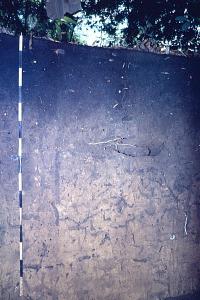| Ah1 0-5 cm |
(7.5YR 2/1, moist) , clay , moderate very coarse crumb and moderate very coarse subangular blocky , slightly hard friable slightly sticky slightly plastic , many very fine fine pores , many pottery inclusions , clear smooth boundary to , |
| Ah2 5-38 cm |
(7.5YR 3/1, moist) , clay , moderate very fine and fine crumb and moderate very fine and fine subangular blocky , slightly hard very friable sticky plastic , many very fine fine pores , many pottery inclusions , clear wavy boundary to , |
| AB 38-89 cm |
dark brown (7.5YR 3/4, moist) , clay , weak fine and medium subangular blocky , friable sticky plastic , many very fine fine pores , gradual smooth boundary to , |
| BA 89-124 cm |
strong brown (7.5YR 5/6, moist) , clay , weak fine and medium subangular blocky , very friable sticky plastic , many very fine fine pores , gradual smooth boundary to , |
| Bw1 124-170 cm |
strong brown (7.5YR 5/6, moist) , clay , weak fine and medium subangular blocky , very friable sticky plastic , many very fine fine pores , diffuse smooth boundary to , |
| Bw2 170-210 cm |
strong brown (7.5YR 5/8, moist) , clay , moderately coherent porous massive , diffuse smooth boundary to , |
| Bw3 210-270 cm |
strong brown (7.5YR 5/8, moist) , clay , moderately coherent porous massive , diffuse smooth boundary to , |
| Bw4 270-360 cm |
yellowish red (5YR 5/8, moist) , clay , moderately coherent porous massive , diffuse smooth boundary to , |
| Bw5 360-400 cm |
yellowish red (5YR 5/8, moist) , clay , moderately coherent porous massive , |
